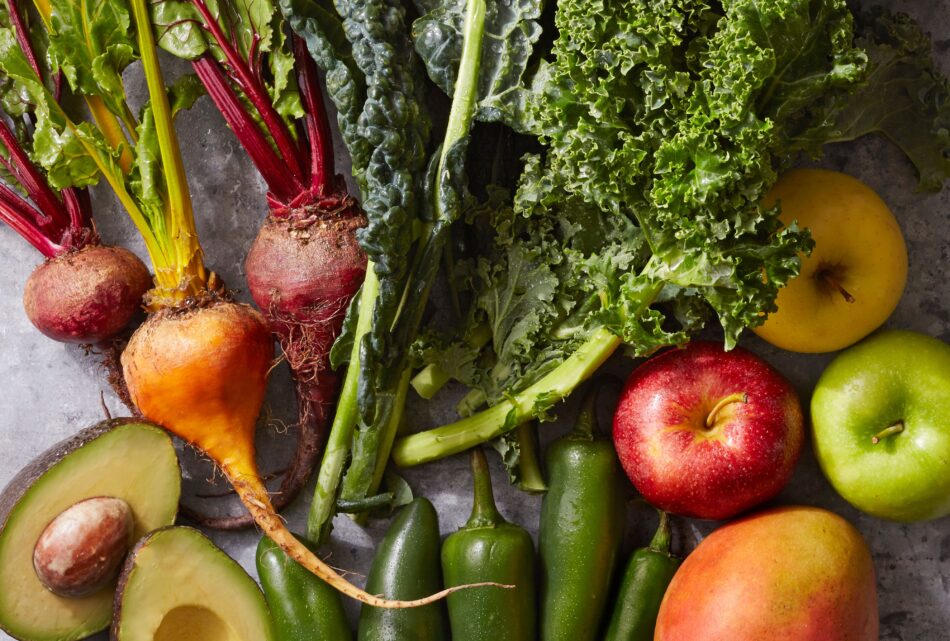Oil and water. Two constantly-squabbling siblings. A flaky croissant and your freshly-cleaned bed sheets.
Certain things are better kept at a distance, including certain fruits and vegetables you should never store together. Sure, it’s easy to toss your entire farmers market or supermarket haul into the same crisper drawer or two, it’s not your best strategy to extend the life of your ingredients. But since fruits and veggies aren’t exactly shouting at each other, for example, or crumbling into pieces atop your crisp white sheets, how do you know which fruits and vegetables you should never store together?
To help us all store in a savvier way and max out the lifespan of our produce investments, we asked our Test Kitchen experts and other culinary pros for their guidance about which fruits and veggies are friends—and which are freshness foes.
- Meggan Hill, executive chef and CEO of Culinary Hill
- Lauren Grant-Vose, founder of Zestful Kitchen
- Chris Meyer, People Inc. Test Kitchen administrative assistant
The Fruits and Vegetables You Should Never Store Together
Some fruits and vegetables should be stored separately because they thrive at different temperatures. For example, cucumbers last the longest when kept in a spot that’s between 50° to 54°F, a bit warmer than the typical fridge setting of 35° to 40°F. On the other hand, tomatoes prefer room temperature, while grapes do best in the fridge at 32° to 36°F.
Some produce also needs to be kept apart to prevent the transfer of strong odors. For example, onions and garlic can overpower the smell and taste of apples, pears, carrots, celery, and other fruits and veggies.
An essential tip for keeping your produce fresh comes from Meggan Hill, executive chef and CEO of Culinary Hill. Her “main rule” is to separate high-ethylene-producing items from those sensitive to ethylene. These knowledge basics will help maximize freshness and reduce spoilage, allowing you to enjoy your produce longer.
Try MyRecipes, our digital recipe box, to stash and organize all your favorite Better Homes & Gardens recipes.
Ethylene is a gas that certain fruits and vegetables emit to cause them to ripen. Without ethylene, that under-ripe rock-hard avocado would remain that rock hard, rather than transforming into its luscious buttery, spreadable, or mashable consistency.
Since ethylene speeds up the ripening—and spoiling—process for certain fruits and vegetables, “when stored too close to each other, ethylene-rich produce can cause ethylene-sensitive produce to ripen too quickly and cause rapid deterioration,” Lauren Grant-Vose, founder of Zestful Kitchen adds.
For this reason, Chris Meyer, People Inc. Test Kitchen administrative assistant, recommends keeping ethylene-producers at least 6 to 8 inches away from the fruits and vegetables sensitive to ethylene gas.
Related: How to Freeze Vegetables From the Garden or Market
Blaine Moats
Ethylene-Producing Fruits and Vegetables
The University of California San Diego (UCSD) Center for Community Health provides a list of fruits and veggies that produce significant amounts of natural ethylene gas. To keep your produce fresh, Lauren Grant-Vose recommends storing these ethylene-producers on their own, away from other produce, in unsealed bags or open containers.
Fruits and vegetables that produce high levels of ethylene gas include:
- Apples
- Avocados
- Bananas
- Cantaloupe
- Kiwi
- Onions
- Peaches
- Pears
- Peppers
- Tomatoes
“Celery, peppers, potatoes, and tomatoes also produce a moderate amount of ethylene,” Hill adds.
Chris Meyer suggests using specialty storage containers or produce-saver sheets to absorb ethylene gas in your crisper drawer, especially if you have these items on hand.
Ethylene-Sensitive Fruits and Vegetables
According to UCSD, the following items are sensitive to ethylene gas. Lauren Grant-Vose advises that proper air circulation is crucial for ethylene-sensitive produce, so avoid sealing them in containers or bags.
Some items are both ethylene producers and sensitive to ethylene. These are highlighted in bold.
Grant-Vose suggests, “If a fruit or veggie is both an ethylene-producer and ethylene-sensitive, store the produce in a single layer rather than stacked or piled into bowls.”
- Apples
- Asparagus
- Avocados
- Bananas
- Broccoli
- Cabbage
- Cauliflower
- Collard Greens
- Cucumber
- Eggplant
- Grapes
- Kiwi
- Lemons and Limes
- Lettuce
- Mangoes
- Melons (cantaloupe, watermelon, honeydew)
- Pears
- Peppers
- Potatoes
- Squash
- Stone Fruits (peaches, nectarines, plums, apricots, cherries)
- Sweet Potatoes
Fruits and Vegetables That Are Not Ethylene-Sensitive
Research into how fruits and veggies interact is ongoing, but the current understanding is that the following items are not highly sensitive to ethylene. This means they can generally be stored alongside other produce without significant issues.
- Blueberries
- Cherries
- Garlic
- Grapefruit
- Green Beans
- Oranges
- Pineapple
- Potatoes
- Raspberries
- Strawberries
- Tomatoes
BHG / Cara Cormack
7 Bonus Tips for How to Make Produce Last Longer
Now that you have our ultimate guide to the fruits and vegetables you should never store together, we couldn’t let our pro panel go without asking them to spill about other ways to slow spoilage and lengthen the life of your fresh garden goodies.
- Flip out. We swear by an old restaurant trick: FIFO, which stands for “first in, first out.” When you put something new in, whether it’s produce or leftovers, place it closer to the back, and bring something older towards the front, Grant-Vose says. “Doing this allows you to keep an eye on your inventory and helps you keep track of what’s fresh and what’s a bit older and ready to be used.”
- Towel off. Paper towels are a wise, budget-friendly tool to help extend the life of many produce items. “Berries, lettuce greens, snap peas, and herbs can all benefit from a paper towel being placed in the storage container,” Grant-Vose says. “Replace the paper towel with a fresh one occasionally if needed.”
- Time the rinse cycle right. If you can wait, it’s best to wash fruits and vegetables right before you eat or serve them, Hill advises. When you get fruits and vegetables home from the market, dry off any moisture before storing them. “Moisture can contribute to spoilage and can encourage bacterial growth,” Hill says.
- Let ‘em breathe. Along with being dry, most produce benefits from circulating air, so store veggies in paper bags or bags with holes—not an airtight plastic bag, Hill suggests.
- Go whole. Instead of cutting, shredding, or slicing immediately after purchase or harvest, keep fruits, vegetables, and herbs whole for as long as possible, Grant-Vose says.
- Mind your onions. Even though both onions and potatoes should both be stored in a cool, dark place outside of the refrigerator, “do not store onions and potatoes together,” Hill warns “Onions release moisture which will lead to mushy potatoes with eyes or roots.”
- Trim the tops. When produce comes with green tops, such as carrots or beets, trim the tops immediately. (Don’t toss them, though! Blitz the leaves into beet or carrot top pesto.) If you leave the tops attached, they can drain moisture, resulting in veggies that are limp or dry.
The Bottom Line
Temperature, smell, and ethylene gas production levels (or sensitivities) can be your guide when considering which fruits and vegetables to store together.
“The easiest rule to follow is to just store like produce together,” Grant-Vose says. “Berries can be stored together, brassica vegetables can be stored together, leafy greens can be together, and most root vegetables (except potatoes) can go together.”
If you’d like to keep your fruits and vegetables beyond their usual best-by date, consider preservation. Check out our Test Kitchen’s canning basics to help you preserve produce for up to a year.









